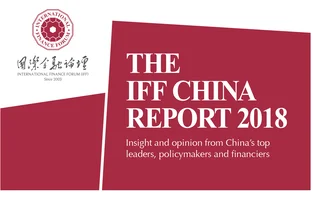
Two plans, one vision
The Belt and Road Initiative – along with the trade and investment opportunities that accompany it – heralds the appearance of the renminbi as a player on the world stage, says Song Min, IFF Academic Committee member and dean of the Centre for China Financial Research, University of Hong Kong


The internationalisation of the renminbi and the Belt and Road Initiative (BRI) form part of national strategies that affect long‑term development and the ‘opening‑up’ of China. Instead of internationalising the renminbi at a single stroke, it makes economic sense to align its international use with real economic developments. The BRI represents an opportunity to do this while adhering to its core principle of a establishing a shared community – a community with a shared vision for the future of mankind. Indeed, greater international use of the renmninbi will also support the BRI – the two objectives are mutually beneficial to each other.
Partnering the BRI and the renminbi
The BRI requires the internationalisation of the renminbi, which has been seen in practice. Between the end of 2016 and the beginning of 2017 in particular, many companies’ internationalisation strategies were challenged by foreign exchange flow due to tightening of capital accounts. Some overseas projects had to be suspended because forex could not be remitted abroad, even though the terms of these projects had been established. However, from a macro-
economic point of view, tightening capital accounts was the rational option. Since 2015, the renminbi has been expected to devalue. This general devaluation expectation has brought heavy pressure to bear on the decline of China’s forex reserves.

Therefore, renminbi internationalisation should be a long-term strategy, but there are certain conditions required to achieve the ideal state. One necessary element is a rational and free financial system; in other words, China will need to embrace market-based exchange rates and the openness of capital accounts. A relatively free financial system requires the development and stability of the domestic financial system and an improved regulatory system. Since 2015, problems have emerged in the capital market, and forex reforms have reflected existing deficiencies in financial supervision and policies, which has destabilised financial markets. Under such circumstances, there will be many obstacles if capital accounts are blindly opened up or if there is a rush to full marketisation of forex.
Therefore, while renminbi internationalisation is a fundamental, long-term requirement to the BRI, it is a goal that needs to be achieved through steady procedure, complying with domestic development and improved regulation.
Countries along the Silk Road Economic Belt have large populations, as well as considerable total economic outputs and trade volumes. Trade and investment between these countries may consider other currencies in addition to the US dollar for business settlement – and the renminbi is not the only option. Countries participating in the BRI also have strong economies. India, for example, is an influential economy and is expected to have huge currency influence in the future. Its population and economic growth rate may also soon surpass China’s.
Renminbi’s big opportunity
It is not necessary for the currency in circulation to be any national currency. Why not adopt currencies that go beyond the limit of sovereign, special drawing right (SDR)‑based currency, for instance – or an emerging electronic currency such as bitcoin? It is an option worth exploring, though national currencies will continue to dominate for a long time – we still need sovereign countries to provide credit support while SDRs, bitcoin and electronic goods have low market acceptance. Here, the renminbi has a better chance.
China is the largest trading body and second-largest economy in the world, and is likely to become the largest economy in the world in the near future. If a country’s total real economy is the largest, the total amount of monetary economy is correspondingly large. Countries would consider a currency with the following qualities as being appropriate to a settlement currency: large trading volume, good liquidity, a large market and low transaction costs. These are the main reasons the dollar has become a major international currency, and the opportunity for the renminbi to internationalise has now arrived.
Some argue, however, that renminbi internationalisation conflicts with the spirit of a community with a shared future – when in such a community, instead of choosing one national currency, or deciding between the dollar and the renminbi, why not create a new currency accepted by stakeholders? Contradictions still exist here. Sovereign currencies, including the dollar, have many advantages as international currencies. The dollar is recognised as a public product, which can have a positive effect, but causes difficulty for the world economy because, when they are in a dominant position, US policymakers are more focused on their own interests. Therefore, in the world currency playground, it is not a bad thing to have competitive currencies.
Research has shown that the entire international monetary system remains more stable with two or three big international currencies. Renminbi internationalisation does not violate the spirit of community with a shared future if it is recognised as a public product, and the BRI is the perfect opportunity to further the internationalisation of the renminbi.
Only users who have a paid subscription or are part of a corporate subscription are able to print or copy content.
To access these options, along with all other subscription benefits, please contact info@centralbanking.com or view our subscription options here: subscriptions.centralbanking.com/subscribe
You are currently unable to print this content. Please contact info@centralbanking.com to find out more.
You are currently unable to copy this content. Please contact info@centralbanking.com to find out more.
Copyright Infopro Digital Limited. All rights reserved.
As outlined in our terms and conditions, https://www.infopro-digital.com/terms-and-conditions/subscriptions/ (point 2.4), printing is limited to a single copy.
If you would like to purchase additional rights please email info@centralbanking.com test test test
Copyright Infopro Digital Limited. All rights reserved.
You may share this content using our article tools. As outlined in our terms and conditions, https://www.infopro-digital.com/terms-and-conditions/subscriptions/ (clause 2.4), an Authorised User may only make one copy of the materials for their own personal use. You must also comply with the restrictions in clause 2.5.
If you would like to purchase additional rights please email info@centralbanking.com test test test







